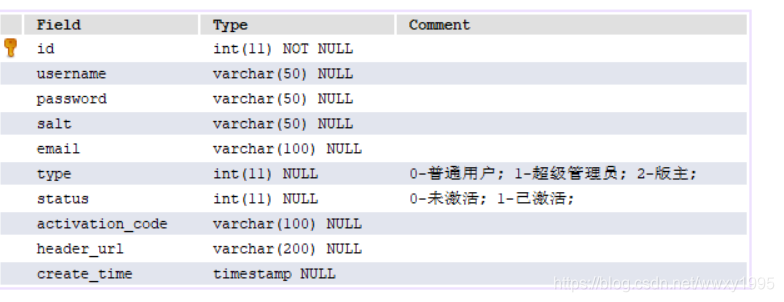社区项目开发数据库准备工作
本文共 253 字,大约阅读时间需要 1 分钟。
首先需要创建一个数据库,并建表导入数据,为后续操作做准备,这一步通常比较繁琐,但在实际项目开发中,除了DBA外,一般很少由开发人员建表
下面是简单的SQL语句
SHOW DATABASES;CREATE DATABASE community;SHOW DATABASES;USE community;SHOW TABLES;
表的创建和数据的导入,使用了外面的两个SQL脚本
数据库由以下几张表构成

其中user用户表的信息如下

消息表如下

下一步,配置MyBatts,完成利用Java代码高效的操作数据库
转载地址:http://bfmv.baihongyu.com/
你可能感兴趣的文章
NIS服务器的配置过程
查看>>
NIS认证管理域中的用户
查看>>
Nitrux 3.8 发布!性能全面提升,带来非凡体验
查看>>
NiuShop开源商城系统 SQL注入漏洞复现
查看>>
NI笔试——大数加法
查看>>
NLog 自定义字段 写入 oracle
查看>>
NLog类库使用探索——详解配置
查看>>
NLP 基于kashgari和BERT实现中文命名实体识别(NER)
查看>>
NLP 模型中的偏差和公平性检测
查看>>
Vue3.0 性能提升主要是通过哪几方面体现的?
查看>>
NLP 项目:维基百科文章爬虫和分类【01】 - 语料库阅读器
查看>>
NLP_什么是统计语言模型_条件概率的链式法则_n元统计语言模型_马尔科夫链_数据稀疏(出现了词库中没有的词)_统计语言模型的平滑策略---人工智能工作笔记0035
查看>>
NLP三大特征抽取器:CNN、RNN与Transformer全面解析
查看>>
NLP学习笔记:使用 Python 进行NLTK
查看>>
NLP度量指标BELU真的完美么?
查看>>
NLP的不同研究领域和最新发展的概述
查看>>
NLP的神经网络训练的新模式
查看>>
NLP采用Bert进行简单文本情感分类
查看>>
NLP问答系统:使用 Deepset SQUAD 和 SQuAD v2 度量评估
查看>>
NLP项目:维基百科文章爬虫和分类【02】 - 语料库转换管道
查看>>